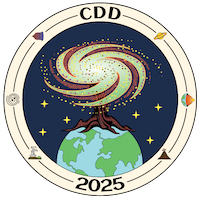Orateur
Description
Ivuna-type carbonaceous chondrites (CI) have
geochemical compositions similar to the solar
photosphere. Their sulfur (S) isotope composition might
thus reflect the average nebular gas. However, most CI
chondrites have undergone sulfur oxidation on Earth.
This may introduce a bias for the determination of S
isotope ratios of the bulk nebula, as sulfide oxidation
causes sulfur isotope fractionation. In contrast with CI
meteorites, samples collected by the Hayabusa2 mission
from the Ryugu asteroid have never interacted with an
oxygen-rich atmosphere. They offer a unique
opportunity to determine the S isotope ratio of CI
objects.
Using wet chemistry and isotope ratio mass
spectrometry, we determined the S speciation and
isotopic composition of the A0481 Ryugu sample and of
a series of CI chondrites. We found CI meteorites to
have 4.5 ± 0.5 wt.% S on average, consistent with
previous estimates. Sulfur is mostly carried by oxidized
components such as sulfates and elemental sulfur (S0).
The Ryugu sample contains 4.5 ± 0.1 wt.% S, similar to
bulk CI meteorites, although S occurs mostly as sulfides.
No sulfates were detected, but we found about 10 ± 3
% of the S in the Ryugu sample to occur as elemental
sulfur.
The S isotope compositions of sulfides, sulfates and
S0 in CI meteorites largely reflect a pattern of sulfide
oxidation. Wether oxidation occurred in Earth or on the
parent bodies is not clear. In contrast, Ryugu sulfides
show unfractionated δ34S values, consistent with
minimal oxidation. The S isotope ratios of the Ryugu S0
is also inconsistent with being produced by sulfide
oxidation. Of all samples measured here, only the S0
from Ryugu exhibits small but resolvable Δ33S and Δ36S
anomalies. We argue that it represents a component
associated with photochemistry in the nebular gas. In
Ryugu, that component has not been erased by the
meteorite weathering that other CI have undergone.
| Speaker information | PhD 2nd year |
|---|

